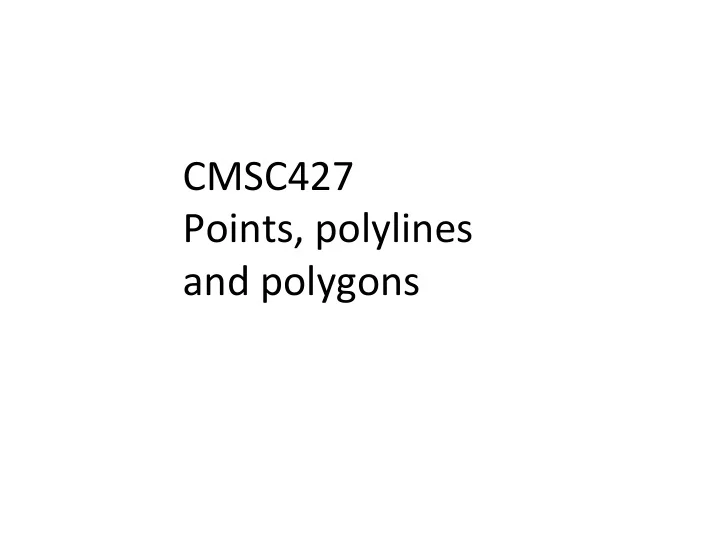

CMSC427 Points, polylines and polygons
Issue: discretization of continuous curve • In theory, smooth curve: • In reality, piecewise discrete approxima@on:
Modeling with discrete approximations Increase fidelity with more points
Points, polylines and polygons Points Polyline Polygon Also called Continuous sequence Closed sequence vertices of line segments of line segments
Polygon properties I • Non-simple • Simple no self-intersec@ons self-intersections no duplicate points duplicate points
Polygon properties II • Concave polygon • Convex polygon Any two points in polygon can Not true of all point pairs inside polygon be connected by inside line
Point in polygon problem Is P inside or outside the polygon? Case 1 Case 2 Case 3
Point in polygon problem Is P inside or outside the polygon? Case 1 Case 2 1 crossing 2 crossings Case 3 3 crossings
Point in polygon problem Is P inside or outside the polygon? Odd crossings – inside Algorithmic efficiency? Even crossings – outside Case 1 Case 2 1 crossing 2 crossings Case 3 3 crossings
Point in polygon problem Is P inside or outside the polygon?
Point in polygon problem Is P inside or outside the polygon?
Other polygon problems • Polygon collision • Return yes/no • Polygon intersec@on • Return polygon of intersec@on (P) • Polygon rasteriza@on • Return pixels that intersect • Polygon winding direc@on • Return clockwise (CW) or counterclockwise (CCW)
Moral: easier with simple, convex, low count polygons Vs
Triangular mesh Vs
Why triangles … Why triangles? 1. Easiest polygon to rasterize 2. Polygons with n > 3 can be non-planar 3. Ligh@ng computa@ons in 3D happen at ver@ces - more ver@ces give smoother illumina@on effects
Polygon triangulation
Theorem: Every simple polygon has a triangulation • Proof by induc-on Base case: n = 3 Induc-ve case A) Pick a convex corner p. Let q and r be pred and succ ver-ces. B) If qr a diagonal, add it. By induc-on, the smaller polygon has a triangula-on. C) If qr not a diagonal, let z be the reflex vertex farthest to qr inside △ pqr. D) Add diagonal pz; subpolygons on both sides have triangula-ons.
Parametric curves vs. polylines • Parametric curves 1. Model objects by equa@on 2. Complex shapes from few values 3. Modeling arbitrary shape can be hard • Polylines 1. Model objects by data points 2. Complex shapes need addi@onal data 3. Can model any shape approximately • Looking forward • Use polylines to control general parametric curves • B-splines, NURBS
What you should know after today 1. Defini@ons of polyline and polygons 2. Polylines and polygons as piecewise discrete approxima@ons to smooth curves 3. Defini@ons of proper@es of polygons (simple/non-simple, concave/convex) 4. Defini@on of point-in-polygon problem and crossing solu@on 5. Triangles are good (simplest polygon, always planar, easy to rasterize, more is good) 6. Defini@on of polygon triangula@on (don’t need to know the theorem yet)
Recommend
More recommend